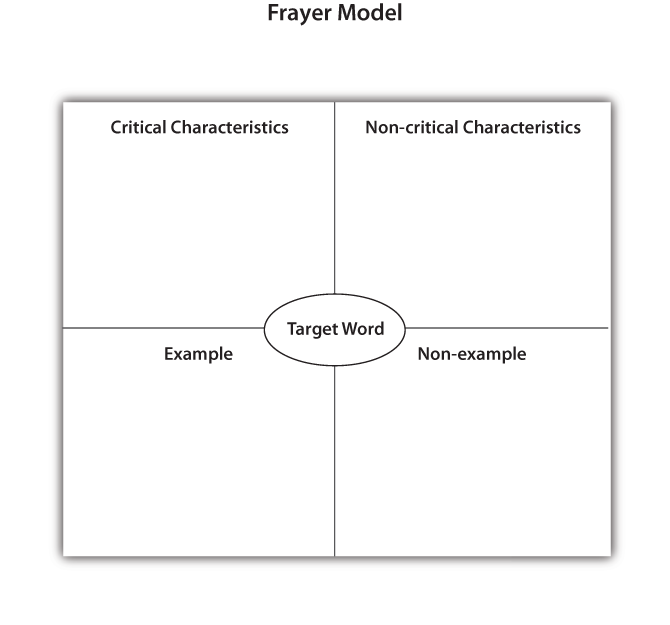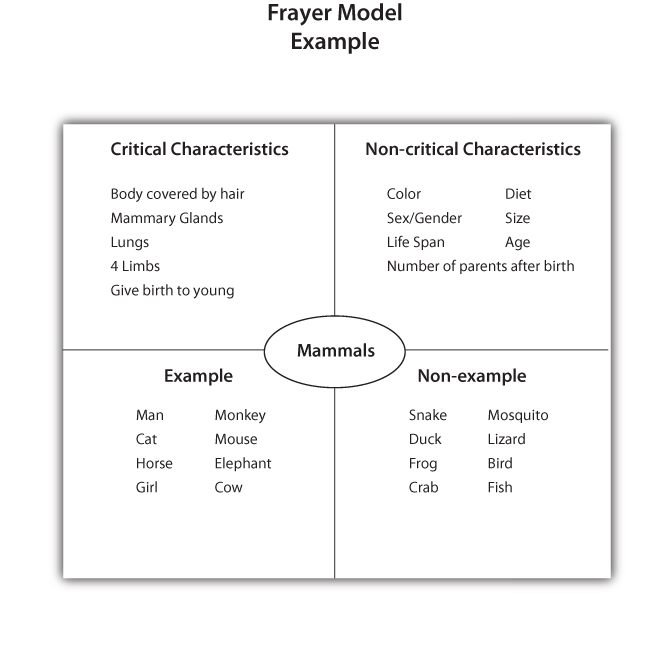Frayer Model
- Upper elementary and above
- Expository and narrative texts
- Vocabulary development
- Assess/develop/activate prior knowledge
- Identify characteristics/traits
- Identify similarities and differences
- Identify examples and non-examples
- Link new concept to prior knowledge
- Make generalizations
- Writing
Teacher Preparation:
Complete the following steps before presenting the concept to students. Gather materials that will make the concept as visual and as real as possible.
- Select a concept that is key to understanding the text.
- Analyze the concept:
- Identify the critical characteristics.
- Identify the non-critical characteristics.
Using mammal as an example:
- Critical
characteristics
- body covered by hair, fur, or wool
- warm-blooded
- vertebrate
- mammary glands
- lungs
- 4 limbs (arms, legs, flippers, paddles, etc.)
- give birth to living young
- (exceptions: duckbilled platypus, spiny anteater)
- two parents
- capable of movement
- Non-critical
characteristics
- (1) color
- sex/gender
- size
- age
- number of parents after birth
- dietary habits
- life span
Strategy Steps:
- Analyze the key word or concept you will be presenting to the students. Develop a list of characteristics that are critical to the definition of the word.
- Introduce the concept and have the students give examples (you may need to use pictures or photographs for younger children).
- Write all of the examples that the students contribute in a list on the board. Do not write in the diagram of the model yet. Encourage students to add to the list or to challenge examples that have been given
- Ask the students what all of the examples have in common. Write their responses in a second list on the board (but not in the model).
- Have the students read the selection and then ask them to add more examples to the first list and to circle those that were not confirmed in their reading.
- Do the same thing with the second list; have the students add more characteristics and circle those that were not confirmed in their reading.
- Present a Frayer Model to the students (see figure below) and write their examples in the appropriate sections (Examples and Nonexamples). Students may need to do some additional research to determine if some of their examples are or are not reptiles.
- Discuss each characteristic in the second list. If the characteristic is present in all examples, write it in the Essential Characteristics section. If the characteristic is present in some examples and not in others, write it in the Nonessential Characteristics column (e.g., a specific color, size, or gender). Students may need to do some additional research to determine if some characteristics are essential or nonessential. This research can be done individually or with partners.
- Students, individually or with partners, write a paragraph using the information in the model to describe the concept of reptiles. When completed, they can share their descriptions with their classmates for discussion. After the discussion, they may revise their paragraphs.

